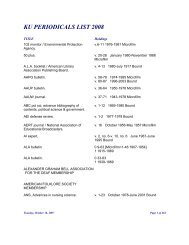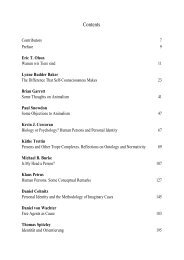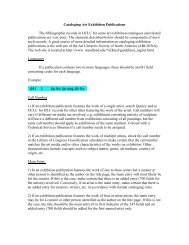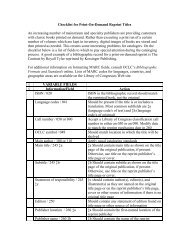Deep-tow magnetic anomaly study of the Pacific Jurassic Quiet Zone ...
Deep-tow magnetic anomaly study of the Pacific Jurassic Quiet Zone ...
Deep-tow magnetic anomaly study of the Pacific Jurassic Quiet Zone ...
You also want an ePaper? Increase the reach of your titles
YUMPU automatically turns print PDFs into web optimized ePapers that Google loves.
B07110<br />
TOMINAGA ET AL.: JURASSIC QUIET ZONE MAGNETIC ANOMALIES<br />
B07110<br />
Figure 12. Curves showing decline in model <strong>anomaly</strong><br />
amplitudes for small-width polarity blocks owing to lateral<br />
interference. Vertical axis is normalized model <strong>magnetic</strong><br />
<strong>anomaly</strong> amplitude. Horizontal axis is width <strong>of</strong> polarity<br />
block. Dotted line is model with vertical polarity block<br />
boundaries; solid line is model with dipping (53°) lateral<br />
boundaries.<br />
field strength, perhaps related to reversal rate. The field<br />
intensity seems to have decreased until reaching a minimum<br />
during <strong>the</strong> LAZ, where <strong>the</strong> fluctuation rate appears highest,<br />
and <strong>the</strong>n increased through <strong>the</strong> late <strong>Jurassic</strong> as reversal rate<br />
declined [Tivey et al., 2006].<br />
[48] Changes in <strong>anomaly</strong> amplitude on <strong>the</strong> deep-<strong>tow</strong><br />
pr<strong>of</strong>iles, particularly around <strong>the</strong> LAZ, may give clues about<br />
<strong>the</strong> origin <strong>of</strong> <strong>the</strong> JQZ. We consider several hypo<strong>the</strong>ses that<br />
may partly or completely explain <strong>the</strong> observed changes:<br />
(1) long-term decrease in crustal magnetization as a result <strong>of</strong><br />
ei<strong>the</strong>r alteration or decreased dipole field intensity, (2) low<br />
transitional field intensities combined with rapid reversals,<br />
(3) interference <strong>of</strong> <strong>the</strong> <strong>magnetic</strong> anomalies caused by closely<br />
spaced polarity blocks in <strong>the</strong> oceanic crust, and (4) a<br />
tectonic disruption in <strong>the</strong> LAZ perhaps caused by spreading<br />
ridge reorientation and/or propagation.<br />
[49] A decrease <strong>of</strong> crustal magnetizationgoing backward<br />
in time has been documented for <strong>the</strong> past 30 Ma and<br />
attributed to progressive alteration [Johnson and Pariso,<br />
1993]. This explanation does not seem likely for <strong>the</strong> JQZ<br />
because existing evidence implies that changes in magnetization<br />
beyond 30 Ma due to alteration are small [Johnson<br />
and Pariso, 1993]. More likely is that <strong>the</strong> overall decrease<br />
in <strong>anomaly</strong> amplitude [e.g., McElhinny and Larson, 2003]<br />
is a global phenomenon related to a decrease <strong>of</strong> geo<strong>magnetic</strong><br />
field strength. Independent, paleo<strong>magnetic</strong> data imply<br />
that <strong>the</strong> <strong>Jurassic</strong> was a time <strong>of</strong> low dipole field strength<br />
(so-called ‘‘Mesozoic dipole low’’) [e.g., Prévot et al., 1990;<br />
McElhinny and McFadden, 2000; Thomas and Biggin,<br />
2003; Biggin and Thomas, 2003].<br />
[50] One possible explanation for <strong>the</strong> LAZ is that <strong>the</strong><br />
geo<strong>magnetic</strong> field was weaker than normal during <strong>the</strong> LAZ<br />
because <strong>of</strong> rapid reversals and overlapping transitional field<br />
minima. It is well-known that <strong>the</strong> dipole field is reduced<br />
during geo<strong>magnetic</strong> field reversals, perhaps only to 25%<br />
<strong>of</strong> <strong>the</strong> nonreversing dipole field strength [Merrill and<br />
McFadden, 1999]. Fur<strong>the</strong>rmore, it is thought that periods<br />
<strong>of</strong> weaker field intensity are characterized by greater numbers<br />
<strong>of</strong> reversals and excursions [Valét et al., 2005]. Thus, we<br />
might expect that a period containing many, closely spaced<br />
reversals may also be a time <strong>of</strong> reduced field strength,<br />
perhaps because periods <strong>of</strong> transition field minima overlap<br />
(i.e., <strong>the</strong> field does not regain full strength before starting<br />
ano<strong>the</strong>r reversal). At face value, our deep-<strong>tow</strong> GPTS for <strong>the</strong><br />
LAZ implies only a reversal rate <strong>of</strong> 10 rev/Ma. This is not<br />
much higher than inferred Miocene reversal rates and<br />
implies an average time between reversals <strong>of</strong> 100 ka. If<br />
transitional field minima have durations <strong>of</strong> less than 10 ka<br />
[Merrill and McFadden, 1999], <strong>the</strong> overlap from polarity<br />
periods <strong>of</strong> <strong>the</strong> implied duration would be minimal. However,<br />
if field minima are broader (e.g., 60–80 ka) [Valét et<br />
al., 2005] or <strong>the</strong> reversal rate is substantially higher,<br />
overlapping field minima may be part <strong>of</strong> <strong>the</strong> reason for<br />
<strong>the</strong> apparent low LAZ <strong>anomaly</strong> amplitudes. Reversal rates<br />
in <strong>the</strong> LAZ may be significantly higher than implied by our<br />
GPTS because this model contains only <strong>the</strong> better-correlated<br />
ano-malies in a zone <strong>of</strong> poor correlation. If all anomalies are<br />
interpreted as a result <strong>of</strong> polarity reversals, <strong>the</strong> model for<br />
deep-<strong>tow</strong> lines 3-9, 4-1 implies a reversal rate <strong>of</strong> 12 rev/Ma<br />
(Figure 10), with an average period <strong>of</strong> 82 ka between<br />
transitions.<br />
[51] Ano<strong>the</strong>r potential factor causing <strong>the</strong> LAZ is overlapping<br />
and partially canceling <strong>magnetic</strong> anomalies caused<br />
by closely spaced blocks <strong>of</strong> opposing polarity. To judge <strong>the</strong><br />
plausibility <strong>of</strong> this hypo<strong>the</strong>sis, we calculated simple 2-D<br />
forward models [Talwani and Heirtzler, 1964] <strong>of</strong> crustal<br />
anomalies and tested <strong>the</strong> reduction <strong>of</strong> <strong>anomaly</strong> amplitude<br />
with different spacing <strong>of</strong> opposing polarity blocks. For<br />
simplicity, we assumed a 1 km thickness for <strong>the</strong> source<br />
layer, a distance <strong>of</strong> 500 m between <strong>the</strong> top <strong>of</strong> <strong>the</strong> source and<br />
<strong>the</strong> observation plane (similar to <strong>the</strong> TN152 deep-<strong>tow</strong><br />
magnetometer geometry), and sharp boundaries between<br />
polarity blocks (i.e., transition width <strong>of</strong> zero). Models were<br />
made at different reversal rates, which varied <strong>the</strong> width <strong>of</strong><br />
<strong>the</strong> polarity blocks. We also made two different models <strong>of</strong><br />
<strong>the</strong> polarity boundaries, one with vertical boundaries and<br />
ano<strong>the</strong>r with boundaries tilting 53° from vertical (<strong>the</strong> tilt<br />
angle inferred for Hole 801C layers by Pockalny and<br />
Larson [2003]). Overall, <strong>the</strong> intensity <strong>of</strong> anomalies from<br />
<strong>the</strong> tilted-boundary model is less than those <strong>of</strong> <strong>the</strong> nontilted<br />
model (Figure 12), presumably because <strong>the</strong> tilted blocks<br />
produce greater overlap <strong>of</strong> opposing polarity material. A<br />
similar result would be given with finite-width polarity<br />
transitions. Most importantly, <strong>the</strong> models show a precipitous<br />
drop in <strong>anomaly</strong> amplitudes when <strong>the</strong> polarity boundaries<br />
are less than 4 km apart and this result is approximately<br />
<strong>the</strong> same for both tilted and non-tilted polarity block<br />
boundaries. This finding implies that even at deep-<strong>tow</strong><br />
depths, <strong>the</strong>re can be a significant reduction in <strong>anomaly</strong><br />
amplitude caused by small-width polarity blocks. In some<br />
portions <strong>of</strong> <strong>the</strong> LAZ, small anomalies imply polarity blocks<br />
4 km or less in width. Thus, <strong>the</strong> partial cancellation <strong>of</strong><br />
overlapping anomalies may be a factor reducing LAZ<br />
<strong>anomaly</strong> amplitudes.<br />
[52] The poor correlation <strong>of</strong> LAZ anomalies may also<br />
result wholly or in part from tectonic and/or crustal accre-<br />
17 <strong>of</strong> 20
















